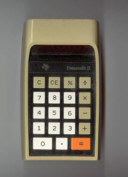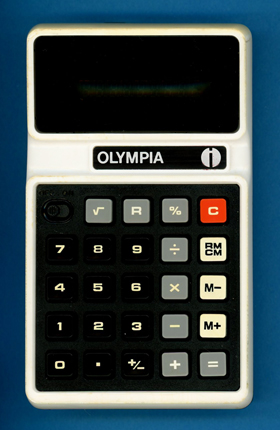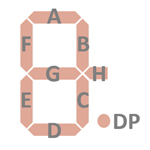
DATAMATH CALCULATOR MUSEUM
 |
DATAMATH CALCULATOR MUSEUM |
Olympia CD44S
| Date of introduction: | 1976 | Display technology: | Fluorescent |
| New price: | Display size: | 8 + Sign | |
| Size: | 5.2" x 3.1" x
1.1" 131 x 79 x 28 mm3 |
||
| Weight: | 4.4 ounces, 126 grams | Serial No: | 0111129 |
| Batteries: | 2*AA | Date of manufacture: | mth 03 year 1976 |
| AC-Adapter: | Origin of manufacture: | Japan | |
| Precision: | 8 | Integrated circuits: | NEC µPD278 |
| Logic: | Chain | Displays: | Futaba 9-ST-10 |
| Memories: | 1 | ||
| Program steps: | Courtesy of: | Joerg Woerner |

![]() Olympia Werke
was founded in 1903 in Germany to develop and manufacture typewriters - please
remember the famous "Mignon". Early in the Seventies Olympia partnered with
Matsushita Electric Industrial Co., better known under their brands
Panasonic
Corporation or National, to stay competitive on the difficult market of
electronic calculators before operations were ceased in 1991.
Olympia Werke
was founded in 1903 in Germany to develop and manufacture typewriters - please
remember the famous "Mignon". Early in the Seventies Olympia partnered with
Matsushita Electric Industrial Co., better known under their brands
Panasonic
Corporation or National, to stay competitive on the difficult market of
electronic calculators before operations were ceased in 1991.
Comparing the keyboard legends of this CD44S calculator and its predecessor CD44 shows only a minor difference, the [CE] key of the CD44 was removed, the [%] key shifted one position to the right and an [R] key added for the CD44S. These subtle changes of calculator keyboards are usually a sign for a replacement of the single-chip calculator circuits used for the products, don't miss Lloyd's Accumatic 30 - going through more than 10 redesigns and sporting four different calculator chips over the course of 1974 to 1976.


 Dismantling
the featured Olympia CD44S calculator manufactured in March 1976 by Matsushita Electric Industrial Co. in Japan
reveals a very compact design based on a single-sided printed circuit board
(PCB) for the main electronics, a single-sided PCB for the keyboard and powered
by two disposable 1.5 Volts batteries or an external power adapter.
Dismantling
the featured Olympia CD44S calculator manufactured in March 1976 by Matsushita Electric Industrial Co. in Japan
reveals a very compact design based on a single-sided printed circuit board
(PCB) for the main electronics, a single-sided PCB for the keyboard and powered
by two disposable 1.5 Volts batteries or an external power adapter.
 The
Main-PCB is centered around a µPD278
single-chip calculator circuit manufactured by NEC and the few other remaining
components on the PCB are mainly used to generate the different supply voltages
for the µPD278 and Vacuum Fluorescent Display (VFD) and to bias the anodes and
grids of the display with respect to its filament.
The
Main-PCB is centered around a µPD278
single-chip calculator circuit manufactured by NEC and the few other remaining
components on the PCB are mainly used to generate the different supply voltages
for the µPD278 and Vacuum Fluorescent Display (VFD) and to bias the anodes and
grids of the display with respect to its filament.
![]() To gain some knowledge about the differences
between the µPD278 located in this Olympia
CD44S and the µPD946 used with the
CD44, we decided here at the Datamath Calculator Museum to give the featured calculator
a full "Teardown Treatment" and share our findings accordingly.
To gain some knowledge about the differences
between the µPD278 located in this Olympia
CD44S and the µPD946 used with the
CD44, we decided here at the Datamath Calculator Museum to give the featured calculator
a full "Teardown Treatment" and share our findings accordingly.
![]() Calculating Unit:
The µPD278 located in the featured calculator is a modification of the µPD946, an enhanced version of the µPD940
- one of the first
"true" single-chip calculator circuits designed by NEC. The pinout and
hardware specifications of the µPD278 and the µPD946 are identical but the
Calculator Logic Implementations and keyboard scanning matrix differ slightly:
Calculating Unit:
The µPD278 located in the featured calculator is a modification of the µPD946, an enhanced version of the µPD940
- one of the first
"true" single-chip calculator circuits designed by NEC. The pinout and
hardware specifications of the µPD278 and the µPD946 are identical but the
Calculator Logic Implementations and keyboard scanning matrix differ slightly:
|
• CD44 - µPD946: [+/−] [M+=] [M−=]
[MR] [MC] [ - ∑] [%] [1/x] [x2] [√x] [PI] • CD44S - µPD278: [+/−] [M+=] [M−=] [MR] [MC] [%] [√x] [PI] [X<>Y] |
![]() Display:
The featured Olympia CD44S calculator manufactured
in March 1976 makes use of an 9-Digit low-voltage VFD manufactured by Futaba and
known as Type 9-ST-10, soldered with its 19 pins directly to the
Main-PCB.
Display:
The featured Olympia CD44S calculator manufactured
in March 1976 makes use of an 9-Digit low-voltage VFD manufactured by Futaba and
known as Type 9-ST-10, soldered with its 19 pins directly to the
Main-PCB.
Display Driver: The term "low-voltage" Vacuum Fluorescent Display might
be misleading when used together with a calculator powered by four 1.5 Volt
batteries. Common VFDs used with portable electronic calculators are usually
operated around 30 Volts, significantly higher than the 10 to 15 Volts operating
voltage of single-chip calculator circuits used in the 1970s. While the first
generation of Texas Instruments TMS0100 single-chip calculator circuits lacked
any display drivers and left the choice of display technology to their
customers, focused the second generation products mainly on Light-Emitting Diode
(LED) technology. In or around 1974, most Western calculator designs still
relied on rather expensive LED technology but Japanese companies like Casio,
Sanyo, Sharp and Toshiba started to leverage the lower manufacturing costs of
VFDs, instead. Texas Instruments introduced in 1974 consequently with the
TMS0850 their first product series focused on battery operated VFD calculators
and modified the integrated segment and digit output drivers to withstand up to
-35 Volts. NEC on the other hand entered the marked of single-chip calculator
circuits in 1973/1974 and focused immediately on compatibility with VFDs. The
µPD278 chips are manufactured in PMOS technology, meaning the
output transistors are "high-side" switching and the most positive voltage of
the chip is labeled VSS for 0 Volt, all other voltages in the
calculator are consequently negative with respect to VSS. Multiplexed
low-voltage VFDs need a voltage difference between its filament and the grids
and anodes of the numbers of around 30 Volts to light up and to avoid "ghosting"
while scanning, the deactivated grids and anodes should be slightly lower than
the filament voltage. An elegant and very common solution is found with this
Olympia CD44S calculator, too. The grids and anodes of the VFD are "pulled-down"
with 17 resistors (150k Ohm) to around -28 Volts, the filament is biased to
around -25 Volts (Zener Diode) and the µPD278 switches the
relevant grids and anodes to around 0 Volt to lit them up.
Clock: The Olympia CD44S makes use of the internal clock
oscillator of the µPD278 Series of single-chip calculator circuits, we identified a
capacitor with
1,500 pF connected between Pin 28 (CLK/CEXT) of the µPD946 and the
positive
VSS power supply line, resulting in a
clock frequency of about 57 kHz.
Power Supply: The Olympia CD44S calculator is powered with
two disposable AA-sized 1.5 Volt batteries or an external 3 Volt power adapter and uses a
complex DC/DC converter to
generate a total of four voltages:
|
• VDD - Negative supply for
µPD278 (-4.7 V) • VGG - Negative supply for µPD278 (-8.7 V) • VPP - Negative supply for VFD anodes and grids (-27.6 V) • VFIL - AC supply for VFD Filament (2.5 V) |
We measured the operating current of featured Olympia CD44S calculator for two different cases:
| Mode | Display | Current VBAT = 3.0 V |
Clock Frequency |
| Calculating | 0. | 46 mA | 57 kHz |
| Calculating | 88888888. | 76 mA | 57 kHz |
Calculating the power consumption at 6 Volts for the Olympia CD44S results in about 130 mW displaying a '0.' and about 230 mW with all segments but the minus sign illuminated. A very interesting result, a Canon LE-84 calculator with a LED display and using four disposable 1.5 Volt Alkaline batteries and a DC/DC converter for its TMS0801 chip clocks in at around 100 mW displaying a '0.' and 320 mW with all segments lit; showing both an advantage and disadvantage of LED-based calculators versus their VFD-based counterparts:
|
• LED: Only illuminated segments draw current - advantage LED while displaying
'0.' • VFD: Filament uses always current, segment currents are almost negligible - advantage VFD while displaying '88888888.' |
 Keyboard:
The keyboard assembly of the Olympia CD44S uses 24
plastic keys pushing small fingers on stamped sheet-metal pieces against
contacts etched on a single-sided phenolic PCB. The sliding power switch of the calculator is
integrated on the
Keyboard-PCB, too.
Keyboard:
The keyboard assembly of the Olympia CD44S uses 24
plastic keys pushing small fingers on stamped sheet-metal pieces against
contacts etched on a single-sided phenolic PCB. The sliding power switch of the calculator is
integrated on the
Keyboard-PCB, too.
 While
most single-chip calculator circuits are using their digit driver outputs to
scan the keyboard matrix, decided NEC to utilize with the µPD278 (borrowed from
the µPD946 Series) the
so-called segment scanning technology. The first part of a complete scanning
cycle outputs the corresponding display information for the nine digits on the
segment outputs, and the second part blanks the display and scans the segment
outputs A to H and DP for possible keyboard actions. A 10th keyboard row
is connected directly to the VSS power supply line to accommodate
keyboards with up to 30 keys, improving the limit of 24 contacts of the
µPD940 Series. The layout of the keyboard
assembly of the featured Olympia CD44S calculator shows consequently an arrangement with
10 keyboard scan lines and 3 keyboard return lines.
While
most single-chip calculator circuits are using their digit driver outputs to
scan the keyboard matrix, decided NEC to utilize with the µPD278 (borrowed from
the µPD946 Series) the
so-called segment scanning technology. The first part of a complete scanning
cycle outputs the corresponding display information for the nine digits on the
segment outputs, and the second part blanks the display and scans the segment
outputs A to H and DP for possible keyboard actions. A 10th keyboard row
is connected directly to the VSS power supply line to accommodate
keyboards with up to 30 keys, improving the limit of 24 contacts of the
µPD940 Series. The layout of the keyboard
assembly of the featured Olympia CD44S calculator shows consequently an arrangement with
10 keyboard scan lines and 3 keyboard return lines.
 Here
at the Datamath Calculator Museum we use
the DCM-50A Platform to
Characterize and
Reverse-engineer
Single-chip Calculator Circuits. Many designs of electronic calculators do not
use all features of their calculator brains and it would be difficult to unleash
the full potential of the calculator chips in these cases. Additionally are
electronic calculators "closed systems" with limited flexibility to measure
signals, change voltages or clock frequencies, provide additional input keys or
even change the display technology or specifications additional digits. Core
idea of the DCM-50A is providing a generic platform to access all features of a
single-chip calculator circuit and with the
DCM-50A (PLAYGROUND) we
increased the scope from Texas Instruments products to offerings from their
competitors in the 1970s, namely AMI, Cal-Tex, Commodore/MOS Technology,
Electronic Arrays, General Instrument, Hitachi, Litronix, Matsushita,
Mitsubishi, Mostek, National Semiconductor, NEC, Omron, RFT, Rockwell, Sharp,
Toshiba, and Western Digital.
Here
at the Datamath Calculator Museum we use
the DCM-50A Platform to
Characterize and
Reverse-engineer
Single-chip Calculator Circuits. Many designs of electronic calculators do not
use all features of their calculator brains and it would be difficult to unleash
the full potential of the calculator chips in these cases. Additionally are
electronic calculators "closed systems" with limited flexibility to measure
signals, change voltages or clock frequencies, provide additional input keys or
even change the display technology or specifications additional digits. Core
idea of the DCM-50A is providing a generic platform to access all features of a
single-chip calculator circuit and with the
DCM-50A (PLAYGROUND) we
increased the scope from Texas Instruments products to offerings from their
competitors in the 1970s, namely AMI, Cal-Tex, Commodore/MOS Technology,
Electronic Arrays, General Instrument, Hitachi, Litronix, Matsushita,
Mitsubishi, Mostek, National Semiconductor, NEC, Omron, RFT, Rockwell, Sharp,
Toshiba, and Western Digital.
 While
the keyboard of the DCM-50A Platform natively supports the segment scanning
approach utilized with the NEC µPD946 Series, is it limited to the segment
outputs A to G and DP as known from Texas Instruments'
TMS0950 and
TMS0970/TMC0900 Product Families. To
overcome some of the limitations of the DCM-50A keyboard, we developed here at
the Datamath Calculator Museum the
DCM50A Playground KBD123
Keyboard with Switch Matrix. It is plugged on top of the DCM-50A Platform and
centered around a 12x3 switch matrix keyboard with patch field for selector
switches with diode matrix. All pins of the matrix (12 Columns, 3 keyboard rows
and 1 switch row) are directly accessible on pin headers and can be connected
with the matching pins on the
DCM50A Playground DIL42 or
DCM50A Playground BB400
Daughter Boards.
While
the keyboard of the DCM-50A Platform natively supports the segment scanning
approach utilized with the NEC µPD946 Series, is it limited to the segment
outputs A to G and DP as known from Texas Instruments'
TMS0950 and
TMS0970/TMC0900 Product Families. To
overcome some of the limitations of the DCM-50A keyboard, we developed here at
the Datamath Calculator Museum the
DCM50A Playground KBD123
Keyboard with Switch Matrix. It is plugged on top of the DCM-50A Platform and
centered around a 12x3 switch matrix keyboard with patch field for selector
switches with diode matrix. All pins of the matrix (12 Columns, 3 keyboard rows
and 1 switch row) are directly accessible on pin headers and can be connected
with the matching pins on the
DCM50A Playground DIL42 or
DCM50A Playground BB400
Daughter Boards.
Comparing the
Calculator Logic Implementation
of the µPD278 retrieved from the featured Olympia CD44S with the
Calculator Logic Implementation
of a µPD946
chip reveals seven major differences:
|
• The µPD278 does not support
an optional [F] key to access the Convenience Functions as 2nd-functions
to the [+], [×], [÷] and [=] keys • The µPD278 does not support Auto-Summation Function of the µPD946 • The µPD278 supports the constant function only for multiplication and division, the µPD946 for addition and subtraction, too • Entering [4] [÷] [=] [=] returns '0.25' with the µPD946 but '0.0625' with the µPD278 • Entering a ninth digit is ignored with the µPD278 but throws an overflow with the µPD946 • The %-Function is implemented differently with the two chips • The [1/x] and [x2] Convenience Functions of the µPD946 were replaced with a Register Exchange Function |
If you have additions to the above article please email: joerg@datamath.org.
© Joerg Woerner, March 4, 2025. No reprints without written permission.